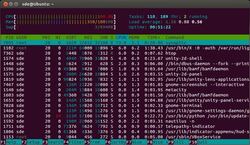news
Best Free and Open Source Software
-
Best Free and Open Source Alternatives to Microsoft Process Explorer - LinuxLinks
Microsoft’s stance for decades was that community creation and sharing of communal code (later to be known as free and open source software) represented a direct attack on their business. Their battle with Linux stretches back many years. Back in 2001, former Microsoft CEO Steve Ballmer famously tarnished Linux “a cancer that attaches itself in an intellectual property sense to everything it touches”. Microsoft also initiated its “Get the Facts” marketing campaign from mid-2003, which specifically criticized Linux server usage, total cost of ownership, security, indemnification and reliability. The campaign was widely criticized for spreading misinformation.
However, in recent years, there has been a partial shift by Microsoft to embrace the open source software paradigm. For example, some of their code is open sourced. Examples include Visual Studio Code, .NET Framework, the now-abandoned Atom, and PowerShell. They have also made investments in Linux development, server technology and organizations including the Linux Foundation and Open Source Initiative. They have made acquisitions such as Xamarin to help mobile app development, and GitHub a hugely popular code repository for open source developers. And they have partnered with Canonical, the developers of the popular Ubuntu distro. But many developers remain hugely sceptical about Microsoft and their apparent shift to embrace open source.
zgenom - lightweight and fast plugin manager for Zsh - LinuxLinks
zgenom is a lightweight yet powerful plugin manager for Zsh.
It is a superset of the brilliant zgen. Providing more features and bugfixes while being fully backwards compatible.
Zgenom provides you simple commands for managing plugins. It installs your plugins and generates a static init script that will source them for you every time you run the shell. We do this to save some startup time by not having to execute time consuming logic (plugin checking, updates, etc) every time a new shell session is started. This means that you have to manually check for updates (zgenom update) and reset the init script (zgenom reset) whenever you add or remove plugins.
This is free and open source software.
jdDiff is a graphical cross platform diff viewer - LinuxLinks
jdDiff shows the difference between two files or two directories.
This is free and open source software.
Raspberry Pi 5 Desktop Mini PC: Passive Cooling the Right Way - LinuxLinks
The Raspberry Pi 5 comes as a bare single-board. For heavy desktop usage, cooling is needed even if the Pi 5 is not housed in a case. A heavy continuous load will mean that the board will go into thermal throttling. Throttling happens as there are software controls to limit CPU speeds if things get too hot.
My first ever truly silent PC was the Hush ATX, a full PC built using pretty standard components (with the exception of the power supply), but without the use of a single fan. It was an awesome piece of hardware being able to keep a Pentium 4 2.8GHz processor beautifully cool. That’s a processor with a whopping 110W TDP. To keep that system cool, the case was a huge slab of aluminium with fins. That case acted as a huge heatsink. It weighed a ton (actually 15kgs). I still have the case today although the power supply died after 5 years usage.
Xnec2c - graphical NEC2 antenna simulation - LinuxLinks
Xnec2c now has a built-in editor for NEC2 input files which can be used to edit geometry or command “card” data. This basic editor displays comment, geometry and command cards in tree views where individual rows, each representing a card, can have their cells edited directly for “raw” entry of data. More useful are pop-up “editor” windows that open when appropriate buttons are clicked or when a selected row is right-clicked with the mouse. These editors allow easier, more convenient entry and editing of individual rows, with no need for detailed knowledge of “card” formats. When editing is completed, the contents of the nec2 editor can be saved in a NEC2-compatible input file which can then be re-loaded by xnec2c for execution.
This is free and open source software.

